An Analysis of Three Ways Traditional Brands Enter the NFT Space
Written by: Tangyuan, Hive Finance News
The cryptocurrency asset market is bearish, leading to a significant decline in demand for NFTs and a notable shrinkage in secondary market trading volume. Data from Dune Analytics shows that in August, the trading volume of Ethereum-based NFTs on OpenSea was only 273,000 ETH, equivalent to $472 million, a 90% decrease compared to the peak of 1.604 million ETH (approximately $4.857 billion) in January this year.
While the NFT market cools down, traditional brands are accelerating their entry into NFTs.
On August 2, Gucci's official Twitter announced that some of its stores in the U.S. would introduce a new cryptocurrency payment method—ApeCoin (APE), the native token of the NFT project Bored Ape Yacht Club (BAYC). At that time, Gucci customers in the U.S. could use APE to purchase goods in-store through the payment infrastructure provided by BitPay. This makes Gucci the first luxury brand to publicly support an NFT project.
On August 1, Tiffany announced the launch of a new NFT project called NFTiff, aimed at creating custom pendants and NFT digital artworks similar to final jewelry designs. The NFTiff series is generated based on CryptoPunk NFTs, with Tiffany's designers recreating the on-chain CryptoPunks series NFT images using physical necklace pendants. The combination of on-chain NFTs with physical products was highly popular, with 250 NFTiff NFTs selling out on the launch day, August 5, at a price of 30 ETH (approximately $54,000) each.
In fact, since 2022, more traditional brands have actively embraced NFTs, with some brands generating significant revenue from them. According to data compiled by Dune Analytics user kingjames23tong, Nike's NFTs have generated over $185 million in revenue for the company. Among traditional brands issuing NFT collectibles on Ethereum, Nike ranks as the top NFT seller, followed by Tiffany, Gucci, and Adidas, which have each earned between $10 million and $20 million through their NFT projects.
So, what forms do traditional brands' NFT strategies take? How do they differ from native NFT projects in the crypto market? What is the operational status of NFT projects launched by traditional brands?
Why Are Traditional Brands Favoring NFTs?
NonFungible released its Q2 2022 NFT report, which showed that in Q2, the NFT trading volume was $8 billion, with 10.1 million NFTs sold and 1.172 million buyers, along with 1.247 million active wallet addresses. The average transaction price for NFTs was $798.
Compared to Q1 of this year, the relevant data for NFTs has shown a decline, but the number of projects and overall user activity has made a qualitative leap compared to the same period last year. With this foundational market, traditional consumer brands have begun to abandon their spectator stance and actively engage in NFTs.
For traditional goods, NFT technology can address issues of product counterfeiting. As non-fungible tokens, NFTs possess characteristics of scarcity and indivisibility, allowing certain content or artworks to obtain a uniquely identifiable digital identity through blockchain verification. Creators can decide the issuance quantity of a work and number them, with every step of circulation and transaction fully recorded on the blockchain, ensuring data transparency. This protects creators while also constraining holders.
Thus, NFTs can serve as digital identity certificates for any product in the real world, theoretically making "everything can be NFT." Due to the traceability, verifiability, immutability, and forgery-resistance of NFTs, they provide the most favorable endorsement for the authenticity and uniqueness of products. This is particularly important for products that require traceability (such as luxury goods and high-end alcoholic beverages), as it can prevent counterfeiting and better leverage their characteristics for value certification of scarce items.
For example, in real life, the luxury goods market is flooded with high-quality counterfeits, and consumers often seek professional appraisal agencies to distinguish authenticity. If the information of these luxury goods were stored on the blockchain and made into NFTs or corresponding virtual products, consumers could verify authenticity by checking publicly available on-chain information (including product materials, production locations, production quantities, etc.).
For brands, NFTs are a new favorite among crypto users and the younger generation, inherently carrying traffic.
On one hand, brands can use NFTs for marketing, digitizing their IPs and making NFTs a bridge to connect with users, creating more scenarios through NFTs to bring new product experiences.
On the other hand, the scarcity inherent in NFTs can even enhance the value of brands or products, as scarcity itself brings a premium to goods. For luxury goods, limited edition products are often sought after by consumers. By introducing NFT products, brands can break the homogeneous competition of mass-produced items, customize offerings to match consumer preferences from multiple dimensions, and further increase scarcity.
Moreover, NFTs are becoming important digital assets within the metaverse, allowing brands to connect with users and build their own metaverse worlds.
For users, NFTs provide the opportunity to participate in brand building, allowing them to transition from consumers to co-developers with brands. For instance, holders of the stick figure NFT mfers have spent their own money to create offline merchandise to enhance the project's visibility and even run advertisements for it.
What Are the Ways Traditional Brands Are Entering NFTs?
The expectations and development paths of native NFT projects in the crypto space are entirely different from those of traditional brands entering NFTs. The former aims to link products in the on-chain virtual world to offline application scenarios, while the latter hopes that NFTs can serve as gateways to the on-chain virtual world.
The starting point for native NFT projects is creator-driven, with development paths propelled by community users, aiming for a co-development of on-chain and offline worlds, hoping to extend on-chain NFT IP into the physical world and provide more real usage scenarios. This is a bottom-up development process from virtual to real. For example, the NFT project Bored Ape Yacht Club (BAYC) has been turned into offline merchandise such as clothing, skateboards, and shoes, while stick figure mfer has offline cafes.
In contrast, traditional brands issuing NFTs hope to leverage them to enter the Web3 or metaverse world, building more online virtual spaces based on real-world brand IPs, allowing brand IPs to have a place in the on-chain world, with development paths guided by the brand itself. This is a top-down development process from real to virtual. For example, beauty brand Estée Lauder issued the Little Brown Bottle NFT (Advanced Night Repair) during the Decentraland Metaverse Fashion Week, allowing users' virtual avatars to enter the bottle and receive wearable NFTs, with their avatars being endowed with a radiant and bright appearance by the Little Brown Bottle, providing users with a new metaverse experience.
Currently, many traditional brands have laid out their strategies in the NFT market and achieved considerable revenue. These brands are mostly consumer brands, with NFT projects that either collaborate with native NFT projects in the crypto market or are independently created by the brands themselves. According to the latest data from Dune Analytics, Nike ranks first among all brands issuing NFTs on Ethereum, with a total revenue of $185 million.
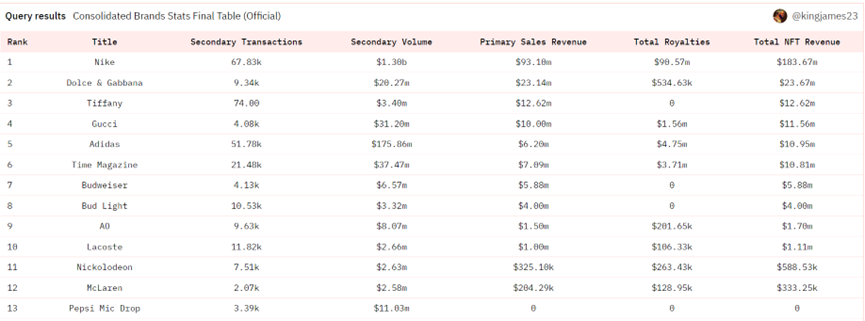
Dune Analytics' statistics on brand NFT revenue
For brand enterprises, embracing NFTs is not just about launching NFT-shaped products; it is a systematic project. Based on the unique attributes of NFTs, companies can create a series of new interactive scenarios that were previously impossible, which can be consumer scenarios, social scenarios, or gaming scenarios. These scenarios can be self-built or rely on external collaborations. Beyond focusing on NFTs as digital assets, brands are more concerned with how to activate a new brand marketing system and user ecosystem through NFTs.
At the same time, NFTs will open new development channels for brands: based on underlying blockchain technology, all NFTs and related transactions can be cross-platform and cross-scenario interactions, meaning that NFTs issued by brands will not be confined to any specific underlying technology.
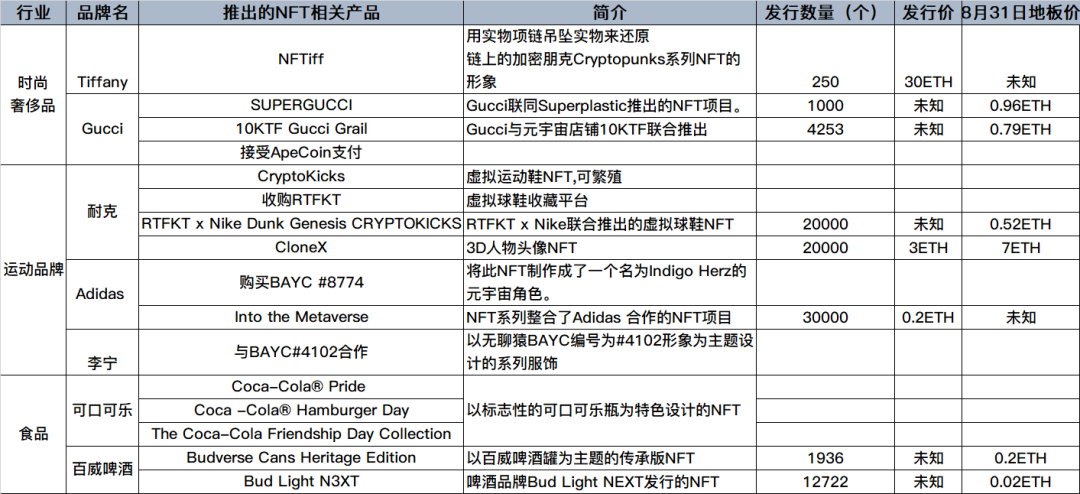 Traditional brands' layout in NFTs, source: Hive Tech
Traditional brands' layout in NFTs, source: Hive Tech
The routes for traditional brands developing the NFT market also vary, which can be categorized as follows:
From Virtual to Real: Obtaining NFT IP Authorization to Produce Physical Goods
Chinese streetwear brand Li-Ning acquires Bored Ape #4102 to create merchandise
In April this year, Chinese streetwear brand Li-Ning acquired Bored Ape BAYC #4102 and subsequently launched the "Li-Ning Bored Ape Trend Sports Club" clothing series, which is themed around the #4102 Bored Ape image, combining the Li-Ning brand with Bored Ape elements. They launched clothing and shoes offline and held a pop-up event called "Bored or Not Bored," where #4102 Bored Ape became the host of Li-Ning's pop-up store.
Jeweler Tiffany & Co. creates CryptoPunk pendants
On August 5, Tiffany & Co. launched its first NFT collection "NFTiffs," which is limited to 250 pieces, each priced at 30 ETH, with a current market price of approximately $55,000. The NFTiff series is generated based on CryptoPunk NFTs, with Tiffany's designers recreating the on-chain CryptoPunk NFT images using physical necklace pendants.
NFTiff is not only a digital artwork but also a 3D design of CryptoPunk and a redeemable pass for receiving a custom Tiffany & Co. physical pendant and standard necklace. After purchasing NFTiff, users are linked to the CryptoPunk represented by the NFT and grant Tiffany the design and production rights, allowing users to receive a customized physical necklace based on the NFT image they hold.
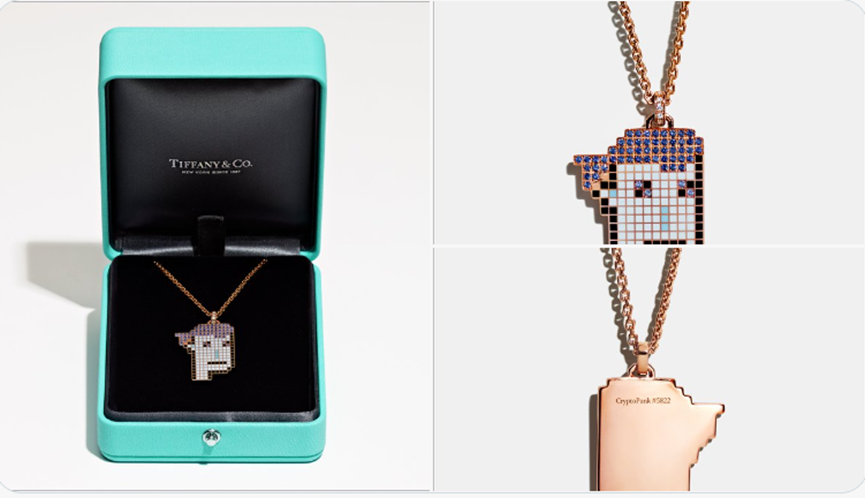
Appearance of the NFTiff physical pendant
It is important to note that NFTiff is only open for purchase to holders of CryptoPunks series NFTs. This means that CryptoPunks holders need to spend 30 ETH to purchase the NFTiff series NFTs and then receive the custom physical pendant from Tiffany. Despite the limited purchase conditions, NFTiff sold out on the launch day, August 5. This marketing strategy brought Tiffany 7,500 ETH in revenue, approximately $12 million.
From Real to Virtual: Using NFTs to Expand into the Metaverse
Nike's three-step approach around NFTs
Nike's early NFT strategy primarily revolved around virtual shoes.
In 2019, Nike launched its first virtual sneaker NFT "CryptoKicks," where each virtual sneaker is an NFT that records its color, style, and other attributes on-chain, with ownership transferring as the NFT changes hands. CryptoKicks later added gameplay elements, allowing various designs of sneakers to evolve continuously, drawing inspiration from the first-generation blockchain game "CryptoKitties," enabling sneaker pairings to generate new sneaker offspring. Unlike before, Nike extended this gameplay to the real world, allowing these sneaker offspring to be produced as custom physical sneakers as long as manufacturers could produce them.
By December 2021, Nike announced the acquisition of the virtual sneaker collection platform RTFKT, coinciding with the boom of NFTs and the burgeoning concept of the metaverse. Prior to the acquisition, RTFKT had launched the 3D avatar NFT series CloneX, which became a blue-chip project in the NFT market.
CloneX is designed for interactivity in the metaverse, utilizing 3D modeling technology to attempt to integrate NFTs with AR devices. RTFKT later planned to develop virtual clothing, aiming to dress CloneX NFT characters in shoes and hats within the metaverse. The company's development and planning trajectory are all directed towards the metaverse, and Nike's acquisition undoubtedly laid the groundwork for its entry into the metaverse.
In February this year, Nike and RTFKT jointly released the first Ethereum-based virtual sneaker NFT series RTFKTNike Dunk Genesis CryptoKicks (hereinafter referred to as RTFKTNDGC), primarily for wearable devices in the metaverse. The total issuance of RTFKT*NDGC is 20,000, with an initial average price of 3 ETH, and its current floor price on OpenSea is 0.54 ETH, approximately $864.
Adidas sells NFTs as metaverse passes
Adidas's NFT strategy is more precise—directly targeting the metaverse.
In December 2021, Adidas purchased Bored Ape #8774 for 46 ETH (approximately $156,000) and created a metaverse character named Indigo Herz from this NFT.
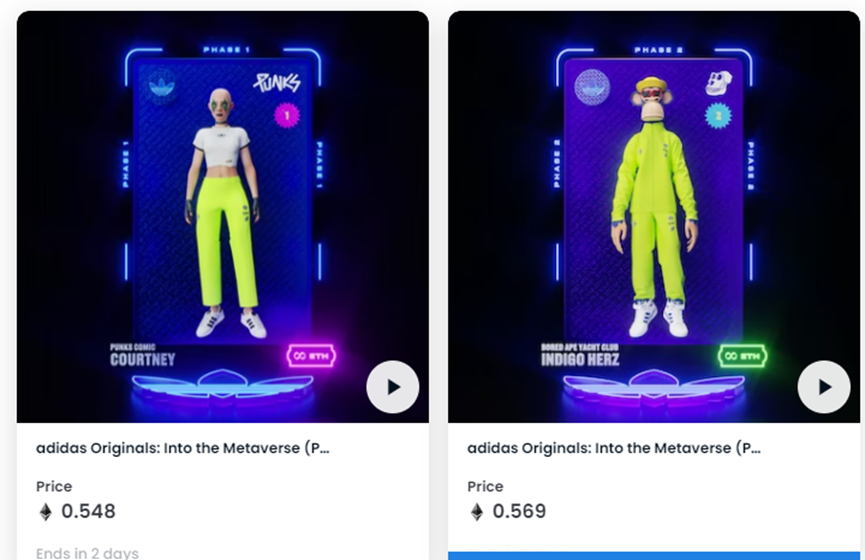
Intothe Metaverse character
That month, Adidas released the "Into the Metaverse" series of NFTs, totaling 30,000, with Indigo Herz as the character image, outfitted with different clothing.
Issuing NFTs is not Adidas's ultimate goal; building a metaverse brand space is. In the core area of the metaverse space The Sandbox, Adidas has a "Land," and in the future, users holding NFTs can use them as free passes to enter this virtual space, allowing their avatars to wear related virtual clothing and equipment. Buyers of Adidas's NFT series not only have the opportunity to enter an exclusive fan club but can also receive physical clothing corresponding to these NFTs.
Coca-Cola NFTizes core elements
In July this year, Coca-Cola collaborated with the 3D virtual avatar application platform Tafi to launch a series of NFTs themed around International Friendship Day, including Coca-Cola® Pride collectibles, Coca-Cola® Hamburger Day, and Coca-Cola® International Friendship Day digital collectibles, primarily designed around the iconic Coca-Cola bottle.
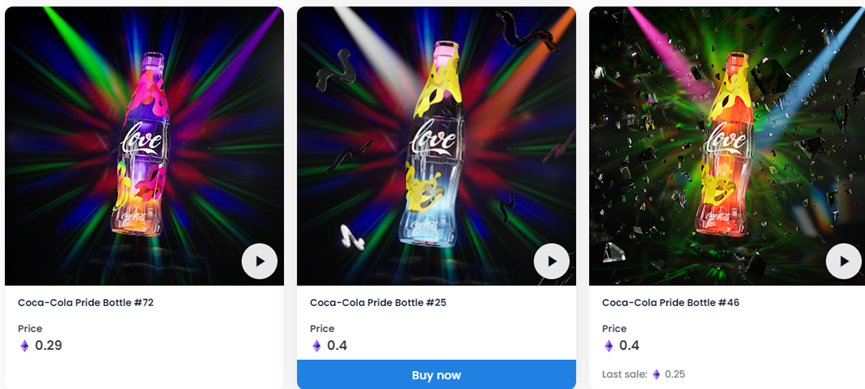
Coca-Cola® Pride series
Prior to this, Coca-Cola also launched Christmas snow globe NFTs. This series of NFTs features falling snow and the iconic Coca-Cola polar bear.
Notably, the Coca-Cola Friendship Loot Box NFT allows players to use it in the metaverse Decentraland, containing a classic Coca-Cola retro fridge, a red Coca-Cola delivery uniform (wearable in Decentraland), a friendship card (designed after 1940s Coca-Cola game cards), and a sound visualizer (playing sounds of a bottle opening, pouring a drink over ice, and the bubbles common in carbonated drinks). Coca-Cola stated that each NFT in the friendship box is meant to commemorate the core elements of the Coca-Cola brand, but they have provided a new interpretation of these elements in the virtual world.
Budweiser NFTizes canned elements
In 2021, Budweiser issued a heritage edition NFT themed around its beer cans called "Budverse Cans Heritage Edition," with a total of 1,936 issued, the number 1936 representing the year Budweiser first launched canned beer and the year the first Budweiser logo was released. These NFTs record significant historical moments, design photos, and the development of canned beer.
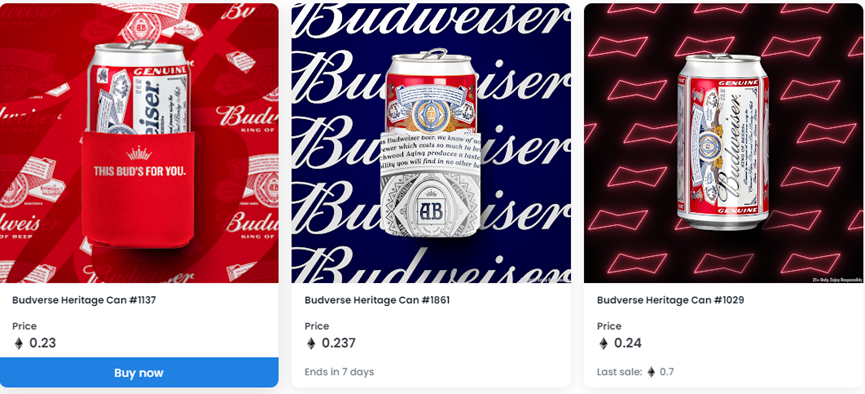
Appearance of Budverse Cans Heritage Edition
Additionally, these NFTs will serve as passes for consumers to participate in Budweiser's metaverse "Budverse," unlocking exclusive benefits and surprise rewards for holders.
In January this year, Budweiser's zero-carb brand Bud Light NEXT launched the "Bud Light N3XT Collection" NFT, with each NFT featuring a design that combines brand background and symbols representing beer culture, with a total issuance of 12,722. After purchasing this NFT, consumers will have the opportunity to vote on Bud Light NEXT products and access Bud Light NEXT brand and partner events.
Blending Virtual and Real: NFTs Sold Alongside Physical Goods
Luxury brand Gucci delves into the crypto sector
Gucci's layout in the crypto sector includes not only supporting APE as a payment method but also the launch of NFT products.
In 2021, Gucci launched NFT series named "SUPERGUCCI" and "10KTF Gucci Grail," as well as the metaverse store "Gucci Vault" series NFTs.
"SUPERGUCCI" is an NFT project launched by Gucci in collaboration with digital collectibles art design company Superplastic, with each NFT design inspired by Gucci's classic totems and showcased by Superplastic's virtual influencers Janky & Guggimon. Each series of Janky and Guggimon consists of 500 NFTs, each accompanied by an 8-inch tall white SUPERGUCCI SuperJanky handcrafted ceramic figurine made by Italian ceramic artists.
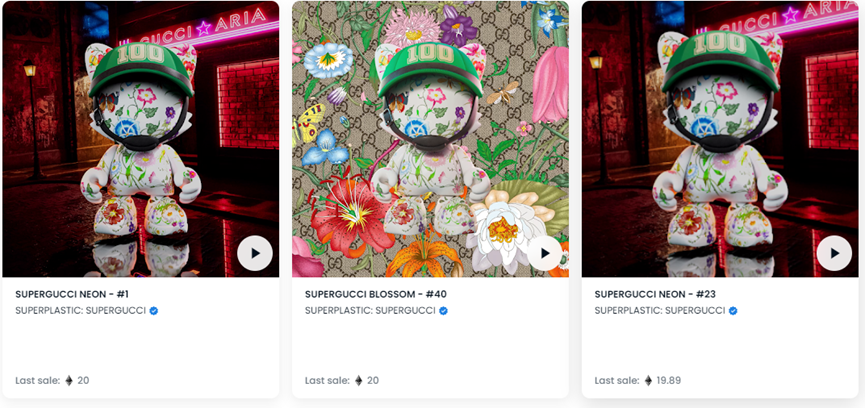
Appearance of SUPERGUCCI NFTs
"10KTF Gucci Grail" is an NFT series co-created by Gucci and the metaverse peripheral design shop 10KTF, with a storyline where Gucci's creative director meets the NFT-dressing digital artisan Wagmi san in the metaverse, designing clothing and accessories for selected NFT avatars, including BAYC, World of Women, Cool Cat, etc.
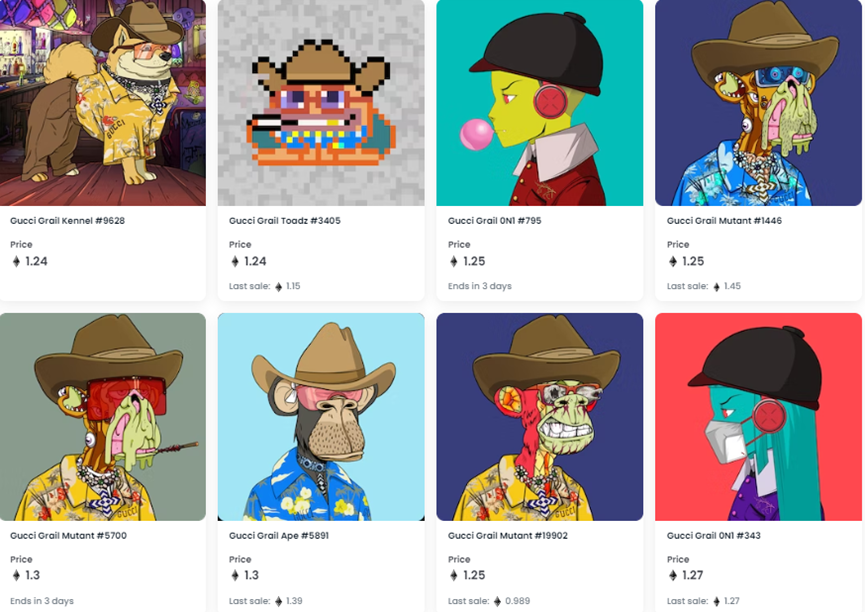
NFT accessories created by 10KTF Gucci Grail
In May this year, Gucci announced the opening of a metaverse concept store "GUCCI Vault" on the virtual land purchased in The Sandbox, where it will launch brand NFTs and vintage bags, releasing virtual wearable items for players in The Sandbox to purchase and wear.











